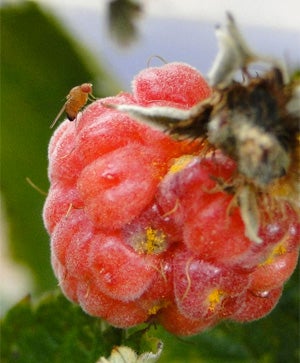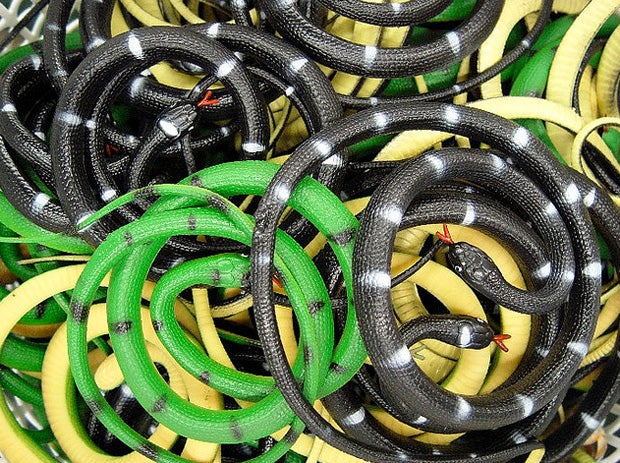Don’t let stinging insects get the best of you!
ListenMike explains how to keep nematodes at bay, what to do when you discover fungi in your garden, a time-old trick for keeping squirrels away, tips for eliminating earwigs, and safe and sane ways to beat wasps and hornets.
Question of the Week:
“I’ve recently noticed a lot of bees near my flower bed, just steps away from my front door. They fly into a hole in the dirt and then more come out. I didn’t know that honeybees nested in the ground. I’d feel bad pouring chemicals in the ground to kill them but I’m very allergic to bee stings. Any advice?”
— Jennifer in Silver Spring , PA
How to get rid of wasps and hornets »
Highlights from show for August 31, 2013:
Marigolds defeating nematodes
Joann from Tallahassee, FL had Root-knot nematodes that completely decimated her garden and when she asked Mike for advice in a passed show, he advised her to pull everything up and till up all the soil and sow in marigolds, which are a natural deterrent to nematodes. Joann wants to know if she can just plop down her raised beds and avoid all that extra work of tilling in the now grown marigolds. Mike exclaims, “Isn’t this the best pest control ever to grow this tremendous flower garden that people just stop and stare at?” Joann agrees and enjoys all the butterflies that are attracted by the marigolds. Mike supports her idea and tells her to go ahead and drop the frames right over top the marigolds as they are starting to fail. The roots of the marigolds should create a mat that the nematodes can’t get passed. It’s like Kryptonite to them!
“Isn’t this the best pest control ever to grow this tremendous flower garden that people just stop and stare at?”
Mike McGrath
-

Photo by Flickr user Guru Hegde
Finding fungi
Mark from Mechanicsburg, PA was recently tending to his potted garden, but found something cone shaped around his mint plants that he can’t identify. They have little black seed pods inside and they have whitish roots. First Mike commends Mark for planting his mint in pots since mint is incredibly invasive. Then he solves Mark’s mystery. “What you are describing sounds like a classic nuisance fungi.” “Rather than living plants these are actually mushrooms and what you’re seeing as seeds are probably spores.” Mike thinks Mark had a rogue spore that blew into his garden and now he has a tiny mushroom farm. Not edible, of course!
Scare your squirrels with fake snakes!
Following up on a previous caller’s squirrel dilemma, Walter from Arkansas shared that what worked best for him was strategically placing rubber or plastic snakes around squirrel hot spots near his home. Walter explained that his home is sided with red cedar, which is a favorite to woodpeckers and squirrels. He picked up some plastic snakes at a dollar store and discovered that by tacking up the fake snakes on a few corners of the outside of his home, this kept both of his pests at bay. Since this worked so well, he hung a few plastic snakes around his tomato cages and found that this also kept his garden squirrel free! Mike agreed that this is an effective, time-proven method, saying: “Plastic snakes are an OLD trick. I mean there are people recommending this back in the ’50s. You put some rubber snakes around and a fake owl or two and depending on the gullibility of your local squirrels, it often works.”
Eliminating earwigs
Lorraine from Wrangell, Alaska is struggling with an earwig population. “Earwigs are a very unusual pest, so to speak, in that they have a bad reputation because they look serious — you know, they’ve got those pinchers, and they run around a lot? But back when I was at Organic Gardening, the best we could figure out was that they might damage some crops a little bit, but they were very beneficial in fruit trees. They would attack pests of tree fruit.” Mike goes on to say that despite their benefits, earwigs can become a nuisance when there are too many. He suggests that Lorraine cut up an old garden hose into four-foot lengths and lay them out in her yard overnight. This technique will create an earwigs’ favorite hiding place and they will hide inside severed hose pieces. In the morning, Lorraine can then dunk the sections into buckets of soapy water to kill off the populations collected. This technique could be used indoors as well, or she could use sticky trap paper to catch intruding earwigs.
Spotted wing drosophila
Jim from Short Mountain, Tennessee has been invaded by spotted wing drosophila. His blueberry and raspberry crops have been attacked by this small fly, and he’s not sure what to do. Mike offers his sincere condolences and explains: “Let me stop you there and explain to our listeners this is a brand new pest, as these things go. It’s an Asian fruit fly. I had only begun to hear about it this year — people were telling me this is something I needed to research and start trying to find answers for. … This fruit fly lays its eggs into the berry just as they’re ripening up, and you can pick that berry and eat it within a week, and everything looks fine. But for instance, if you package them up to sell, and somebody puts them in their fruit a week later than that, all these little maggot-y worms come popping out of the berries. It’s the most disgusting thing in the world.” Mike continues to explain that since this pest is so new, there isn’t much research on which to build a plan of action. Mike McGrath goes on to make an on-air plea to any expert listeners out there to please get in touch with knowledge about this new, devastating pest problem.
“This is a brand new pest, as these things go. It’s an Asian fruit fly. … This fruit fly lays its eggs into the berry just as they’re ripening up, and you can pick that berry and eat it within a week, and everything looks fine. But for instance, if you package them up to sell, and somebody puts them in their fruit a week later than that, all these little maggot-y worms come popping out of the berries. It’s the most disgusting thing in the world.”
Mike McGrath
-

Spotted wing drosophila. Photo by uacescomm
WHYY is your source for fact-based, in-depth journalism and information. As a nonprofit organization, we rely on financial support from readers like you. Please give today.




